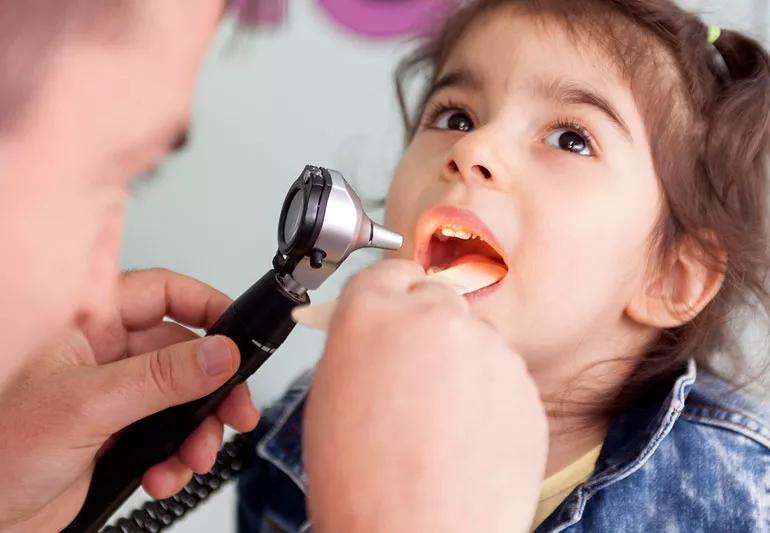The reasons for this common surgery

Tonsils, those two clusters of tissue in the back of the throat and their counterparts, the adenoids, are located just behind the nose. Their purpose is to help filter out harmful bacteria and viruses that are breathed in, protecting the body from infection. (Although adenoids typically shrink by age 7, and are virtually nonexistent by the teen years). But for some children, they are more trouble than they’re worth.
Advertisement
Cleveland Clinic is a non-profit academic medical center. Advertising on our site helps support our mission. We do not endorse non-Cleveland Clinic products or services. Policy
Pediatric otolaryngologist Rachel Georgopoulos, MD, says the most common reasons for removal — a tonsillectomy and/or adenoidectomy — are recurring throat infections and airway obstruction. (While doctors do these procedures mostly on children, some adults also opt for them as well, she says.) Here’s what often happens:
Some children have larger tonsils and adenoids than others, and they sometimes interfere with breathing. This is a problem particularly at night because the body is in a reclined position. It can cause a serious health condition known as sleep apnea — short periods of time when breathing stops during sleep.
If a child has severe sleep apnea, Dr. Georgopoulos says she will also perform an endoscopy prior to the tonsillectomy/adrenalectomy to do a thorough evaluation of the child’s airway while they are sleeping.
“Symptoms of sleep apnea in children can include snoring at least four nights out of seven, pauses in breathing followed by a ‘catch-up’ breath, restless sleep, sweating, tiredness and even bed wetting,” says Dr. Georgopoulos.
The effects of poor sleep also carry over into the waking hours. Children may show restless or erratic behavior, irritability and poor coping skills. “Removing tonsils and adenoids to help correct airway obstruction is so effective that many patients no longer experience sleep apnea,” she says.
Advertisement
“For children 3 and older, the surgeon usually removes both tonsils and adenoids. On occasion we will address tonsils in children younger than 2, and we will do what is called an intracapsular tonsillectomy, which is partial removal of the tonsil tissues,” she says.
Recurring throat infections mean defenses can’t keep up. Tonsils help keep bacteria and viruses out but, because they are one of the body’s first lines of defense, they are sometimes overwhelmed and infected themselves.
If your child has frequent throat infections (like strep throat) that include a fever and swollen lymph nodes lasting for three or four days, talk with your doctor about whether a tonsillectomy and adenoidectomy would help.
“Frequent” means:
Surgery to remove tonsils and/or adenoids is usually well-tolerated, with most children going home a few hours later. Tylenol® or ibuprofen help manage pain, and patients usually recover in seven to 10 days, says Dr. Georgopoulos.
She adds that surgery sometimes also helps with:
The good news is that surgeries to remove tonsils and adenoids are among the most common outpatient pediatric surgeries — and most children recover quickly.
Advertisement
Learn more about our editorial process.
Advertisement

Jaundice that’s present at birth or lasts more than a week should be evaluated by a pediatrician

There’s more than one way to potty train, but this intensive method can kickstart the process

Clean your baby’s mouth with a washcloth or small toothbrush if they have a tooth or you suspect thrush

A glass child is the sibling of someone with special needs — often seen as the easy one, but carrying invisible burdens

This dangerous practice can cause burns or a ruptured eardrum, and can make earwax blockages worse

Babies can be noisy little sleepers! Blame small nasal passages and short sleep stages

Yes, you can have honey if you’re breastfeeding — but never feed it directly to babies under 1

Earlobe piercings heal quicker and are less painful than cartilage piercings — proper cleaning and care are important

If you’re feeling short of breath, sleep can be tough — propping yourself up or sleeping on your side may help

If you fear the unknown or find yourself needing reassurance often, you may identify with this attachment style

If you’re looking to boost your gut health, it’s better to get fiber from whole foods